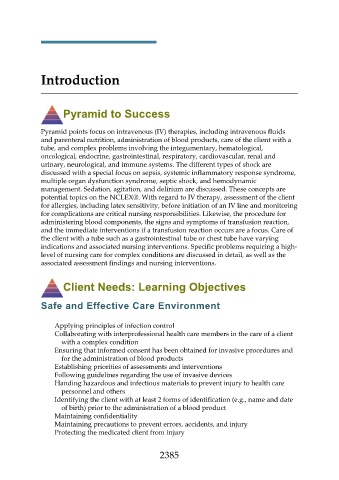Page 2385 - Saunders Comprehensive Review For NCLEX-RN
P. 2385
Introduction
Pyramid to Success
Pyramid points focus on intravenous (IV) therapies, including intravenous fluids
and parenteral nutrition, administration of blood products, care of the client with a
tube, and complex problems involving the integumentary, hematological,
oncological, endocrine, gastrointestinal, respiratory, cardiovascular, renal and
urinary, neurological, and immune systems. The different types of shock are
discussed with a special focus on sepsis, systemic inflammatory response syndrome,
multiple organ dysfunction syndrome, septic shock, and hemodynamic
management. Sedation, agitation, and delirium are discussed. These concepts are
potential topics on the NCLEX®. With regard to IV therapy, assessment of the client
for allergies, including latex sensitivity, before initiation of an IV line and monitoring
for complications are critical nursing responsibilities. Likewise, the procedure for
administering blood components, the signs and symptoms of transfusion reaction,
and the immediate interventions if a transfusion reaction occurs are a focus. Care of
the client with a tube such as a gastrointestinal tube or chest tube have varying
indications and associated nursing interventions. Specific problems requiring a high-
level of nursing care for complex conditions are discussed in detail, as well as the
associated assessment findings and nursing interventions.
Client Needs: Learning Objectives
Safe and Effective Care Environment
Applying principles of infection control
Collaborating with interprofessional health care members in the care of a client
with a complex condition
Ensuring that informed consent has been obtained for invasive procedures and
for the administration of blood products
Establishing priorities of assessments and interventions
Following guidelines regarding the use of invasive devices
Handing hazardous and infectious materials to prevent injury to health care
personnel and others
Identifying the client with at least 2 forms of identification (e.g., name and date
of birth) prior to the administration of a blood product
Maintaining confidentiality
Maintaining precautions to prevent errors, accidents, and injury
Protecting the medicated client from injury
2385

